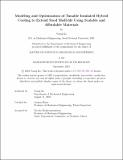Modeling and Optimization of Tunable Insulated Hybrid Cooling to Extend Food Shelf-life Using Scalable and Affordable Materials
Author(s)
Ko, Young
DownloadThesis PDF (7.255Mb)
Advisor
Henry, Asegun
Terms of use
Metadata
Show full item recordAbstract
Cooling is a pivotal technology for tackling the global food crisis by securing the food shelf-life. More than 15% of food loss is due to improper food storage temperatures in developing countries. Every 10℃ temperature drop can increase food shelf-life by 2-3 times. However, conventional electrically powered cooling technology, such as vapor-compression refrigerators, is readily unavailable in developing countries. To this end, passive cooling, including radiative and evaporative cooling, is a promising solution that enables daytime sub-ambient temperature without any power requirement. However, radiative and evaporative cooling are constrained by low energy density, climate conditions, and significant water consumption.
In this work, we combine evaporative and radiative cooling into tunable insulated hybrid cooling (TIHC) that can deliver low-cost, high-performance passive cooling for post-harvest foods. TIHC comprises three functional layers: hydrophobic porous membrane for radiative cooling, polyacrylamide hydrogel for evaporative cooling, and aluminum sheet as a substrate. Instead of the state-of-art radiative cooling material that requires complex and expensive fabrication, TIHC leverages commercially mass-produced hydrophobic porous membranes to achieve optical selectivity. In addition, an air gap between the membrane and the hydrogel insulates the cooling structure to reduce environmental heat gain. Concurrently, the air gap provides tunability to optimize the cooling performance by modifying the insulation thickness.
Based on the TIHC concept, we implement a one-dimensional heat and mass transfer model to predict the cooling performance. We accelerate the computation time by a physics-based approximation of radiative heat transfer, which decouples it from conductive heat transfer. As a result, the model can simulate cooling performance for diverse design parameters, including optical properties of the hydrophobic porous membrane, air gap, polyacrylamide hydrogel, and storage free-space thickness. Next, we fabricate a surface-level TIHC cooler and characterize its cooling performance through outdoor cooling experiments. Cooling power and stagnation temperature difference for three different hydrophobic porous membranes (polyethylene film, polypropylene film, and polytetrafluoroethylene film) are measured and compared to the model predictions. We obtain a good agreement between the experimental data and the model predictions. However, the cooling performance of all tested hydrophobic porous membranes is inferior to pure evaporative cooling due to insufficient solar reflectance. Nevertheless, the TIHC cooler achieved an 81.6% of temperature drop with 48.8% less water consumption compared to the pure evaporative cooler throughout the day.
Finally, we propose several optimization strategies to improve the TIHC cooling performance. We identify desired optical properties of the hydrophobic porous membrane to outperform pure evaporative cooling. We also discover a trend-shifting of cooling power to air gap thickness depending on the food temperature, from which optimal air gap thicknesses to maximize cooling power are determined. Eventually, we simulate the transient food temperature profile and quantitatively predict the food-shelf life under real-time weather conditions. The simple design of TIHC food storage is expected to improve the shelf-life of red tomatoes by up to 231.7% in Kenya, Nairobi. Given its compact structure, low-cost scalable materials, and tunable cooling performance, we expect the successful deployment of TIHC food storage can bring promising benefits to farmers, businesses, and households in developing countries.
Date issued
2023-09Department
Massachusetts Institute of Technology. Department of Mechanical EngineeringPublisher
Massachusetts Institute of Technology